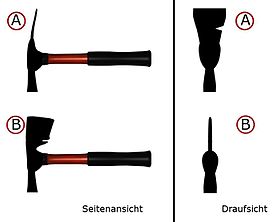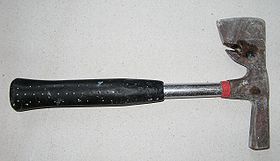Mason's hammer
The bricklayer's hammer is a special hammer that bricklayers use to strike stones in the correct shape. This is done with the sharp horizontal edge on the rear side of the hammer head. This edge distinguishes the mason's hammer. The path of the hammer head resembles that of a carpenter's hammer , with which you only drive in nails or pull out with the fin using a groove .
The bricklayer's or plasterer's ax is similar , which instead of the horizontal one has a vertical blade approx. 5 cm long, which is exceptionally blunt (about 30 degrees) so that the cutting edge is not damaged by hard stones. The mason's ax is usually equipped with a nail notch in the underside of the ax side, with which you can pull protruding nail heads.
The mason's ax is mainly used to remove old plaster or work on pumice stones ( lightweight concrete stones ). As a rule, the ax or edge side is used to knock a groove and thus a predetermined breaking point into the brick / stone with one or more blows . Then the stone is placed just above the edge and the piece to be cut is then knocked off with the hammer side. In the case of narrow hollow blocks , the piece can be knocked off with the ax / edge side in individual cases. The right technique for a clean, smooth break in the desired location requires a lot of practice.
One differentiates bricklayer's hammers according to the Rhenish and Berlin forms. The Berlin model has a flatter but wider rear side (narrow web / fin) and a nail lifter attached to the side. The Munich, Dutch and American forms are less common.
The foundation stone hammer is a special form of the mason's hammer (Berlin model) . This is an artisanal replica (often made of pure silver and with chiselling ), with which the client or architect solemnly commits the laying of the foundation stone .
Very similar, but simpler, is the prospecting hammer of the geologist , who is not designed for pulling nails.


